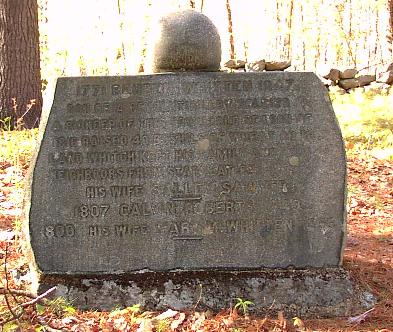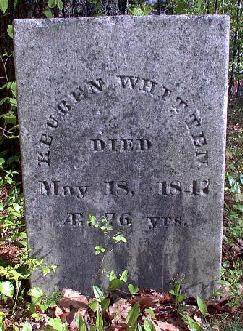1816: The Year without a Summer
A New Hampshire Perspective
by Eric Werme
In April 1815, Mt. Tambora,
a volcano on an Indonesian island, first stirred and then exploded.
Of the 12,000 inhabitants of the island, only 26 survived. 4,000 feet
of the volcano was blown off, the ensuing eruption ejected an
estimated 25 cubic miles of debris. As in many large eruptions, dust
and sulphate aerosols were injected into the stratosphere and took
months to gradually settle back to the troposphere where weather
systems could wash them back to the ground.
The eruption
was the biggest of perhaps the last 10,000 years, dwarfing
Krakatoa (1883, 4.5 miles3) and Mt. St. Helens (1980, 1
mile3). The stratospheric cloud stretched around the Earth,
spread north throughout the northern hemisphere, and reflected enough sunlight
to affect weather patterns. In some parts of the world, the impact was minor
but in much of Europe it caused near famine conditions. In New England it
helped changed history.
 In 1816, family farms were largely subsistence affairs. Transporting crops
to the cities was feasible only along waterways. The major crop was Indian
corn, most which was fed to livestock during the long winters, but it was a
staple for human consumption too. Wheat was prone to a fungus, apples and
potatoes did well. (Johnny
Appleseed was in the middle of his career, planting apple trees throughout
the new states around Lakes Erie and Michigan.)
In 1816, family farms were largely subsistence affairs. Transporting crops
to the cities was feasible only along waterways. The major crop was Indian
corn, most which was fed to livestock during the long winters, but it was a
staple for human consumption too. Wheat was prone to a fungus, apples and
potatoes did well. (Johnny
Appleseed was in the middle of his career, planting apple trees throughout
the new states around Lakes Erie and Michigan.)
Several cold spells in May 1816 delayed the start of the planting season.
June began well, but crops were lost in a cold spell between the 5th and 11th.
Snow accumulated throughout all but southernmost New Hampshire. A warm spell
starting the last third of June provided hope that summer had arrived, but a
killing frost on July 9th dashed that hope. The rest of the month was warmer,
but didn't equal the warmest days of June. A warming trend in August abruptly
ended with frost on the 21st and a worse one on the 30th.
Some crops did well, apple and pear harvests were very good, perhaps due
in part to the cold weather being hard on insect pests. Potatoes did
well too. Some people were able to raise a good crop of wheat, and
they were rewarded with prices that were double that of normal years.
Increased farm efficiencies have exceeded inflation - the high price
was never equaled until the 1970s.
 In Ashland, Reuben Whitten shared his wheat crop with his
neighbors. After his death in 1847, they paid for his headstone in
his family graveyard. Later, relatives erected a monument saying "A
pioneer of this town. Cold season of 1816 raised 40 bushils of wheat
on this land whitch kept his family and neighbours from starveation."
His farm was on a south facing hillside, so probably benefited from
the extra sun and being above the valley chill.
In Ashland, Reuben Whitten shared his wheat crop with his
neighbors. After his death in 1847, they paid for his headstone in
his family graveyard. Later, relatives erected a monument saying "A
pioneer of this town. Cold season of 1816 raised 40 bushils of wheat
on this land whitch kept his family and neighbours from starveation."
His farm was on a south facing hillside, so probably benefited from
the extra sun and being above the valley chill.
After 1816, the weather returned to normal conditions quickly. However,
farmers had already started emigrating to the more hospitable weather and soil
of Ohio and further west. This migration helped accelerate the construction
of the Erie
Canal, which started construction in 1817 and was completed in 1825.
Others went to the mills in Manchester and Lowell, others went to the
seaports of Nantucket and New Bedford to learn the whaling trade.
Another impetus to the westward migration was an energy crisis - much of the
accessible first growth forest had been cut for construction, fuel, and
products. Today's New Hampshire is much more forested than it was in 1816.
The westward emigration decimated the population of many farming
communities in New Hampshire. To this day, many northern towns have a
smaller population than they had in 1816, many more exceeded the old
population only when NH began a long growth phase after 1960. Ashland
was part of Holderness until 1868. They, and neighboring Plymouth,
have rivers with waterfalls, so their economy could shift to manufacturing.
In fact, Holderness was in the midst of a growth boom. In
1820 its population climbed to 1160 after growing of 57% and then 40%
in the previous decades.
Plymouth's northwest neighbor, Rumney, is a better example. While
it grew 22% and 13% to 864 in 1820, it declined to 820 by 1960! (In
2000, population reached 1480, with most of the growth between 1970
and 1990.)
Much of this WWW page comes from Henry and Elizabeth Stommel's book
Volcano Weather. It was published the year after the El Chichon
eruption in 1982 which brought an end to azure skies for a couple years. That
eruption let scientists discover that the sulphuric acid aerosol in the
Stratosphere was more important than dust in terms of longevity and sunlight
reflecting. The book has a good summary of the research and computer models
of the day and graphs that show the beginning of the recent apparent climb in
world temperatures.
An easier reference to find is their article in the June 1979 Scientific
American which formed the basis for the book.
The Stommels' accounts are the most complete, at least as far as
the effects in New England. Of course, anyone who knows anything
about New England weather would expect that David Ludlum's writings
would be the primary reference - the Stommels' essentially stand on
his shoulders. They also refer to some books by J.D. Post written in
the 1970s that look at the economic crisis due to the food shortages
in 1816. Many oceanographers have stood on Henry
Stommel's shoulders.
Many libraries have Scientific American on microfiche. Volcano
Weather is available at the Concord
NH Public Library, the Lamson
Library at the Plymouth NH State College and the Metro Boston Library
Network.
Personal note: I read about the Ashland monument when the Scientific
American article came out. At the time, my parents had a second home in
Plymouth, next door to Ashland. I've always wanted to see the monument in
place, but never pursued it until the activity "Geocaching" was invented and I
became active. It occurred to me that the monument could be an ideal geocache
site as it is significant, but not enough to warrant commercial or state
development. With assistance of the WWW, I gleaned it was in a cemetery near
Highland Street, and I was able to find it on my own on 2002 May 17. The
next day while I was cooking breakfast in a lodge in Woodstock, I watched rain
change to snow. While I've seen other memorable snow storms in May, it felt
very, very weird to be seeing 1816 weather the day after visiting the 1816 monument!
If you want to visit the monument yourself, details are on the
Summerless
Geocache page. The cemetery is surrounded by private property, so tread
with respect.
Over Christmas in 2005, the National Geographic cable channel's
Naked Science program ran a program on what might happen if there
were another supervolcano eruption. While the program itself was
not very good, it referred to events in Yellowstone in 2003, the last
time I visited there, and the effects the eruption could have on weather. That
referred to 1816, and they have a scene with a geologist visiting
the Whitten monument.
For the 200th anniversity in 2016, I
wrote A Tale of Two Freezes, a detailed
look at the weather in NH between April and September. Read it some day when you
have the time.
While I was researching before writing this page, I came across a new
theory that adds another possibility to "abrupt climate change." Decreasing
salinity in the North Atlantic seas around Greenland may override the
Gulf Stream, cutting off a major heat source for Europe. This can
happen in just a few years and there is evidence for such sudden changes in
Greenland ice cores. I delve into this a bit more and offer links to
better pages at 2016: The [Next] Year without a Summer.
It's an interesting theory and deserves to be more widely known. Now
that it's featured in this year's summer disaster movie, well, let's just
say it deserves to be better understood.
Later on I realized that 1816 was part of the Dalton Minimum, a period of
reduced solar activity. Such periods tend to be cooler than usual and
the years leading up to 1816 were cold and difficult. Napoleon's invasion
of Russia in 1812 suffered dreadful losses, many of them due to the early and
harsh winter during the return from Moscow.
We may be entering a similar period of solar inactivity. Solar Cycle 24
was expected to begin in 2006, it may not start until 2009. Long lived
cycles and low sunspots numbers are key signs of reduced activity. We have
just begun to learn enough about the sun to make predictions, and something
similar to the Dalton Minimum is common theme.
Should that happen, then the scenario in 2016 won't play out. On the other
hand, we might revisit the weather that destroyed Napoleon's army. See
Science, Method, Climatology, and Forgetting
the Basics for more about what this means to climatology.
Contact Ric Werme or
return to his home page.
Last updated 2016 June 7.
 In 1816, family farms were largely subsistence affairs. Transporting crops
to the cities was feasible only along waterways. The major crop was Indian
corn, most which was fed to livestock during the long winters, but it was a
staple for human consumption too. Wheat was prone to a fungus, apples and
potatoes did well. (Johnny
Appleseed was in the middle of his career, planting apple trees throughout
the new states around Lakes Erie and Michigan.)
In 1816, family farms were largely subsistence affairs. Transporting crops
to the cities was feasible only along waterways. The major crop was Indian
corn, most which was fed to livestock during the long winters, but it was a
staple for human consumption too. Wheat was prone to a fungus, apples and
potatoes did well. (Johnny
Appleseed was in the middle of his career, planting apple trees throughout
the new states around Lakes Erie and Michigan.)
 In Ashland, Reuben Whitten shared his wheat crop with his
neighbors. After his death in 1847, they paid for his headstone in
his family graveyard. Later, relatives erected a monument saying "A
pioneer of this town. Cold season of 1816 raised 40 bushils of wheat
on this land whitch kept his family and neighbours from starveation."
His farm was on a south facing hillside, so probably benefited from
the extra sun and being above the valley chill.
In Ashland, Reuben Whitten shared his wheat crop with his
neighbors. After his death in 1847, they paid for his headstone in
his family graveyard. Later, relatives erected a monument saying "A
pioneer of this town. Cold season of 1816 raised 40 bushils of wheat
on this land whitch kept his family and neighbours from starveation."
His farm was on a south facing hillside, so probably benefited from
the extra sun and being above the valley chill.